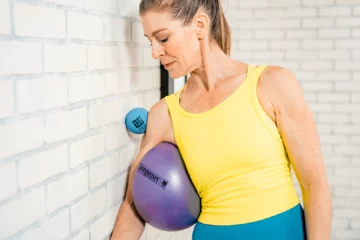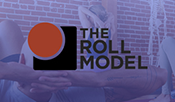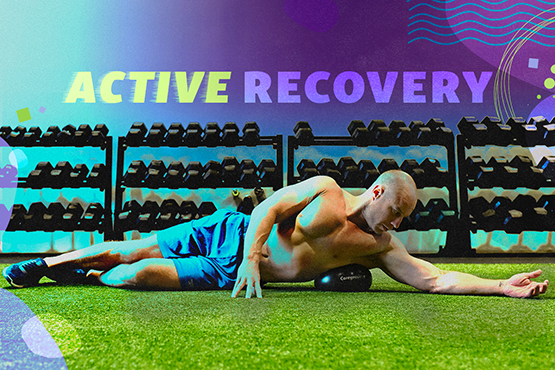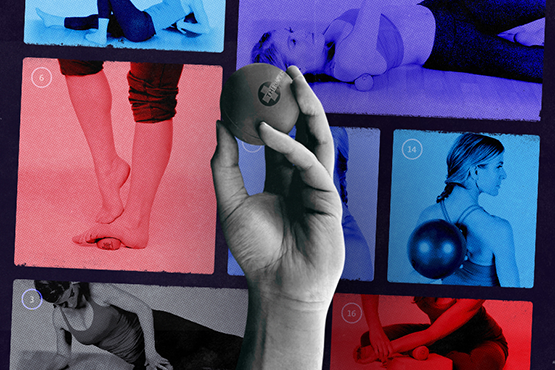
In Part 1, I described the anatomy and function of the pelvic diaphragm. Now I’ll talk about how to take healing into your own hands and care for your pelvic diaphragm before any problems arise, or reverse the tension or weakness that you are currently experiencing.
Unfortunately, due to shame, fear or embarrassment, many people suffer in silence with pelvic floor dysfunction, which left untreated will only worsen over time. Even more troubling is the fact that when people do seek help, they may be given bad advice from professionals untrained in the area of pelvic floor health. The best advice is to seek out a pelvic floor physiotherapist, or a certified Yoga Tune Up® teacher.
When the pelvic floor is weak and unable to properly support the lower abdominal organs, it can result in incontinence of the bladder or rectum, prolapse of an organ causing pain or discomfort, weak muscles supporting the vagina or prostate – affecting sexual pleasure and function, and even inefficient respiration and a general lack of core strength and stability. When the pelvic floor is hypertonic and tight due to too much “clenching”, it can result in pain, restricted movement, constipation, urinary retention, vaginismus (excessively contracted vagina causing pain during intercourse) and poor breathing mechanics. (In this case – no Kegels! – lengthen PF muscles) Also, imbalance and dysfunction in the pelvic floor muscles can refer pain anywhere in the body!
Here are some great exercises helpful in maintaining or strengthening your pelvic floor.
“Tune Up Tadasana” Posture! Get brain over heart, ribcage over pelvis – breathe.
SQUAT! – breathe – relax pelvic floor (if PF weak –pull up gently on exhale, relax on inhale)
Uddihyana Bandha –connect respiratory & pelvic diaphragms, massage abdominal viscera
Happy Baby – pry open the pelvic floor, encourage sacral nutation, cultivate awareness
Baddhakonasana – stretches pelvic floor and adductors
Adductor Slides – strengthen inner thigh muscles and pelvic floor
Frog Crawls/Frog at the Dock – open pelvic floor and hips
Moon Rises Minivini – external and internal hip rotation
Savasana – Breathe, Relax and Renew – down-regulate nervous system
In addition to these pelvic floor exercises, roll out with you Yoga Tune Up® Therapy Balls – special attention to hips and buttocks, lower back, feet and lower legs. Also, you can try very gentle compression on the perineum with a soft, “broken-in” ball, and soft cushioning under the ball.
Finally, get to know your body – all of it – including your perineum, your pelvic diaphragm and all adjacent and related muscles. Learn how to isolate and differentiate between the actions of these muscles, and how to feel and control contraction and relaxation of them.
For help with this:
Find a Yoga Tune Up® teacher in your area and start tuning up!
Julie Wiebe PT – YouTube channel – watch “The Fit Floor” parts 1,2,3 and “The Core Machine: Gears Gotta Move” www.juliewiebept.com
Katy Bowman – www.alignedandwell.com
Blandine Calais-Germain – “The Female Pelvis- Anatomy and Exercises”











I love this blog as a way to understand from the perspective of prevention and also how to help people should they need it after the fact. it’s so frustrating the more personal trainers don’t encourage people to talk about this and the importance of strengthening the pelvic floor, especially for women. I’ve been in HIIT classes and women joking that they can’t do jumping jacks or they’re pee their pants and the jokes just continue rather than actually teaching people how they can reverse it. Great examples of YTU poses that can help!
Thanks for thé séquence .. i ça y était to truc it for myself since i have Been struggling to gent my body back for a few year now.
Wow thanks! These ideas will be useful to me in my teachings with my student mothers among others!
Hi Lynda, I am wondering if you yourself experienced this leakage when working out at any time in your life?
I was happy to read that so many accessible shapes from the yoga world, as well as the YTU program can assist with maintaining a healthy PF. When I first read the title and saw SQUATS I thought that might have been the primary pose / action to do. Though I do know I probably need more of these for multiple reasons, so I will add more of these in to my practice.
I will introduce these YTU exercises in my post-natal classes this fall. Thank you.
Women are too often unaware of the importance of this muscle. In my group classes, I often hear that women train with a sanitary napkin. We need to educate our students about this. Post-natal fitness should, in my opinion, be focused on this area of the body first and foremost.
As for my personnal story I had much more results doing exercices like squats and abdominals than the Kegel’s. Those are great tips, thanks
Thanks for all the tips on the poses to help strengthen the pelic floor ✨
Thanks for the sequence which addresses the pelvic floor in manifoldly ways.
thanks for both articles and this list of poses to work with. I feel like someone should mention that people need to be gentle and consistent in working with the PF. Being an impatient warrior going at it intensely won’t help. consistency is essential.
I was very interested to find that you could roll out your perineum with a broken-in ball. One reason I first purchased the acuball was that Dr. Cohen had talked about it being able to release the pelvic floor and I couldn’t figure out how to do it with the YTU balls. Thank you for the helpful sequence. As the pelvic floor helps us to breathe, I assume if we release the pelvic floor, we breathe better, too.
Great article with helpful suggestions
So excited about this article and repertoire of movements, although it is sad to notice the misconception of relation between having a weak pelvic floor or one that is too tense and the exercises that are being given. I find this is a subject that is not addressed enough, so thank you for sharing.
Thank you for offering up more poses than just the squat as a way to connect with and strengthen/lengthen the pelvic floor muscles. I will definitely be incorporating some of these poses into my sequences for my prenatal classes – these ladies definitely need to know a lot about the pelvic floor in order to prepare for birth as well as heal postpartum.
Great suggestions on what to practice to maintain an healthy pelvic floor, I like that you added the “Tune Up Tadasana” which I learned this week in class ans engaging the tubular core also get’s the job done. I would add some pranayama breathing engaging the mula banda.
What a wonderful article! Health of the pelvic floor isn’t discussed enough in general. Your article was a great reminder to take more time to practice exercises and poses that are beneficial for the pelvic floor. The list of poses is fantastic. Thank you!
Is there a video on how to properly squat?
Very and happy and excited that this is being written about. So helpful and looking forward to incorporating these exercises into my routine!
Indeed, so important for our lives when we sit so much.
What about perineal scarr tissue following childbirth? Any information on stitching resulting in misalignement of superficial tissue or underlying muscles? To my sense, this would create some imbalance whatever rolling balls or movement we practice.
Thanks for sharing.
There is never enough information on pelvic floor health.
This sequence is a great way to introduce a class to pelvic floor exercises and at the same time inform them about the pelvic floor and the possible problems as you mentioned. If we can inform more people, it will help in the education and reduce the embarrassment .
Awesome sequence of poses! Thank you for outlining some of the ways people can experience pelvic floor dysfunction and explaining why kegels are not always the answer. We do a great service to our communities by talking more about this.
Thank you Lynda for this educational article. You are right when you say we do not talk about this enough. This is such a personal issue and one that I feel we are afraid to discuss, but education is power! This is just as important as strengthening the obvious blind spots in our body. I will be incorporating the exercises you listed above into a regular routine. Some of which I wouldn’t have even thought of as exercises to strengthen the PF.
Thank you for the wonderful list of poses that are beneficial for the pelvic floor. It’s nice to see that you paid attention to the fact that some people need this area to be stronger and tighter while others may need to loosen up a bit. It’s all about balance ! I will definitely be using these moves in my future classes, this is a sensitive yet very important subject !
Thank’s for all this pose to work with my pelvic floor. I will do for me and my clients.
Thank you for your insight with the exercises and the connections with the pelvic floor musculature. This will be a very helpful reference.
Thank you for the great info on the pelvic floor. I didn’t realize that it could be the indicator for something happening elsewhere in the body. It makes sense and I am glad you also provided a list of exercises that can help round out any practice for overall health.
Thank you for writing and giving links to additional information for a “sensitive” area, but hello??? There are muscles down there and people need not ignore them!! The perineum is so sensitive, but needs pliability and balance of strength. Love the list to provide a template for classes.
Merci, vous me confirmez que la respiration uddhyana (adominal vacuum) est vraiment bonne pour assouplir le plancher pelvien.
Useful list on how to strengthen our pelvic floor muscles. More people should be talking about this. Next time it comes up with my friends, I’ll refer them to your exercises for a strong and supple pelvic floor. Thanks.
Merci pour ces suggestions d’exercices pour renforcer le plancher pelvien. Une des choses que j’ai appris dernièrement à ce sujet c’est qu’il se peut que l’incontinence soit du au fait que notre plancher pelvien est contracter, c’est intéressant de savoir qu’il y a différente raisons pourquoi il peut y avoir des problèmes d’incontinence.
Thanks for this great article
I absoloutely love that this is being blogged about! And I am so grateful for your reference to vaginismus, because I have realized quite possibly I am a sufferer of such a condition. I practiced pilates for less than a year, and as my core felt so good, I started realizing that I would pee when I sneezed, but then when I needed to pee, it too all my possible concentration to relax and let it come out. And then, the last bit had to be FORCED out! I told my instructor this, and he said, oh wow, no more kegeling for you. And yet, I needed more than just stopping the kegeling! I then proceeded to change jobs, do geographicals, sat A LOT for almost a year, and little did I realize the pattern that has lead to this place of pain with sex! I am so excited to practice this list of exercises and I am already envisioning a class as I am about to finish my YTU Level 1!!! What a relieving and wonderful feeling to know that my cervical exams were not bunk, there’s really not a disease issue, but there’s a hypertension issue! Oh counter nutation and kegeling! Thank you thank you thank you for this post!
Powerful article. Love your sequence.
Thank you for shedding light on this sensitive subject. For years I thought that I needed to strengthen my pelvic floor, so I did. Now I’m beginning to realize the effects of a hypertonic pelvic floor and need to release these muscles.
The number of replies to this post indicates the interest that people have in this area. Yesterday in our training one of the participants was in awe of the the effects of the therapy ball massage on her pelvic floor and body. I have stopped my unintentional dribbling with the therapy balls and some relaxation. I needed less tighteness in my pelvic floor and the therapy balls helped loosen things up SO when I engage my bum muscles I worry that I’m re-tightening my pelivc floor…. It feels like it anyway. Thoughts?
Thank you for the sequence and the suggestion of compression with a “broken in” yoga tune up ball. I will be using this myself and with my students.
Wonderful article! People are now starting to emphasize functional exercises for pelvic floor stability over Kegel’s, but rarely do you find such a comprehensive list of suggested postures. In addition to the exercises, one should also consider overall digestive health. It’s important to know which foods are most compatible with your body’s digestion, drink plenty of water and make sure that you’re walking in a position that benefits your body. These all contribute to good pelvic floor health.
I am hoping our Level 1 teacher has time to show us the pelvic floor ball rolling on the perinium. I had a complete tear from my 1st pregnancy and would like to add that part of my body in hopes that it connects to all the other Yoga Tune-Up exercises we are doing.
Thank you for the list of poses to deal with this area. The specifics on what each pose does is helpful to encourage students to keep practicing. It does make a difference!
What an amazing article! (I really liked part 1 as well–super-clear functional anatomy lesson.) I never knew that pelvic floor dysfunction could be healed without surgery. Thank you for opening my eyes, and for your links to Julie Weibe’s exetremely informative videoes. I’ll definitely be researching this more!
Great article with concrete examples of what to do to strengthen the pelvic floor. This is a subject that I definitely want to explore more. Thank you for this! 🙂
I’m so excited to see that Moon rises help to strengthen the pelvic floor. They feel absolutely delicious to do and I have so many clients who struggle with pelvic floor dysfunction. If you are one of them, don’t feel alone, it is very common!
Wow, thanks for this! I must admit that the pelvic floor is a foreign area to me, especially strengthening it. The poses you provided give me a concrete way to work on building awareness in this area.
I am really excited to try out this routine for myself and my students. I have found that my breath, especially my exhale, has helped me understand how to engage pelvic floor. Also sitting on a block and or birthing ball and feeling that engagement of pelvic floor moving up and down have been great tools. Again the importance of being able to contract and relax is so important to always mention to our students. Thank you again for the above sequence to keep pelvic floor muscles strong and supple.
I do some of these exercises with my pregnant clients, but I look forward to trying a few more – the frog walk perhaps. I’m not sure what moon rises minivini means?
Hello Lynda – thank you for both articles. When it comes to squatting, I wonder if there is a goal depth (provided range of motion is not an issue) for the squats for this pelvic floor therapy? To 90 degrees, below the hip crease (CrossFit style) or all the way to the bottom? Thanks!
Hi again,
I love the idea of focusing on the pelvic floor while in the bottom of a squat, I had never put that together.
I can even see the possibility of putting a YTU ball on a block, squatting onto that and staying there for a while!
Thanks for the post.
Nikola
An important topic to deal with for so many women. This subject has also been discussed in YTU classes I have been attending. Thank you for such a great post.
I was just discussing this issue with a client. So many women that I know are beginning to get to the stage that being unprepared for a cough or sneeze produces very embarrassing results. Everyone constantly says, “kegels, kegels”. I knew there had to be another answer out there. I’m really looking forward to adding “Moon Rise Mini-vinis” to my next class.
I loved the moon rises and now am more motivated to explore. I’m fascinated by opportunities to strengthen the pelvic floor. Your list of pelvic floor asanas is a gift, thank you.
This is information’s so valuable! I have serval clients who have recently had babies and there is not a lot of information out there for them for strengthening the pelvic floor. I have been wanting to offer a post natal yoga class and this article will support my vision.
Honestly all of us need to take care of our pelvic floor to keep our sexual health and lower abdominal muscles in good shape. Thank you!
Wow! I never thought about someone’s pelvic floor being too contracted. Of course, this isn’t the case for me after 4 children and Crohn’s Disease. However, I’m ready to take back control of my pelvic floor. Thank you for the wonderful list of exercises and resources. No doubt I’ll be referring to this post and those resources often. Guess I better get squatting!
I love that the pelvic floor has become such a hot topic in the yoga and fitness world! As a prenatal yoga teacher, I work with so many women who would benefit from connecting to their pelvic floor pre-birth or who are struggling with issues post-birth. All most of them have heard is “Kegels, kegels, kegels!” and it’s truly a process of becoming aware of what it means to awaken and connect to the pelvic floor in a way that is balanced and integrated. Thank you for both of these posts about it!
[…] Tune Up® Blog « Stop Migraines Before They Start With YTU Therapy Balls For Strong And Supple Pelvic Muscles – Squat! […]
Over and over again I keep on hearing about the benefits of squats. I love the way that it engages the pelvic floor and even helps stabilize the spine. I have added squats to my practice and feel more stable all over, from my core, legs and spine!
Over and over again I keep on hearing about the benefits of squats. I love the way that it engages the pelvic floor and helps stablize te
Thanks so much for the response, Lynda! I will definitely look into the resources that you mentioned. Thanks so much!! Had my first anatomy dream last night…the quadratus lumborum…then just realized now that a lady asked me today about that exact muscle. Weird!
Also, I Can’t Leave Out gentle compression and gentle rolling on the perineum with a nice soft broken-in Yoga Tune Up® Therapy Ball. And also rolling of the feet and lower legs, hips and buttocks, adductors, IT Band, lower, middle and upper back. 🙂
Hi Bev! Well, the “short answer” is SQUAT!! (that is, squat in good form) to maintain strong and supple gluteals and pelvic floor muscles. As well – correct posture is key! The spine needs to maintain it’s natural lumbar curve – sacrum nutated (as in anterior tilt), to maintain the length of the pelvic floor muscles. When the spine looses its lumbar curve(as in posterior tilt or tucked tail) the sacrum becomes counter-nutated and creates a short, tight and weak pelvic floor. As “we, the people” spend so much time sitting, and so many of us sit with our tails tucked in poor posture, just the act of sitting poorly can lead to PFD. And I LOVE Bridge Lifts with Uddihyana Bandha as with this practice we stretch and strengthen both the respiratory diaphragm and the pelvic diaphragm, and get to feel the synchronicity of their movements. And I can’t leave out Adductor Slides! In addition to the resources I have listed above, I highly recommend purchasing Jill Miller’s “Healthy Pregnancy, Healthy Baby” Webinar from “Creative Live”. It is jam packed full of valuable information directly pertaining to pelvic floor health from the leading experts – Jill Miller of course, Katy Bowman, Kelly Starrett, Esther Gokhale and more. Also, Katy Bowman’s book – “Alignment Matters” has an awesome chapter on the pelvic floor – with excellent “squat” instruction – or google “Katy Bowman blog “you Don’t Know Squat”. And YES Bev! We certainly had an awesome week in St Catharines! 🙂 xo
Lynda hello!!! Great follow article. I have to admit I was a little lost in all the Latin/muscular names of the first article though I found the diagram that was attached helped me to gain a general sense of the main muscular trinity of the pelvic floor. As I mentioned in my earlier comment I know so many people who suffer with a ‘wee pee’ when they don’t want one. I have a question: I know all the exercises mentioned help but are there specific ones that would be more effective? Thanks for the article and thanks for everything over the past week 🙂 xx
Currently in the YTU TT with Todd and Amanda in Ontario , We had the chance to experience the perineum release with a (not so broken) TU ball! As you get over the fear factor of putting something so near those “sweet” parts (I am also currently 20 weeks on in my pregnancy ) , the effects during and after the myofascial release is amazing. Done many workshop focusing on pelvic floor, mula bandha , etc but never felt soooo clearly the relationship of the diaphragm with the pelvic floor and the ischios moving back and forth as you breath ! definitely a keeper for me !
Very informative blog. I agree this is something most women are embarrassed about and don’t want to talk about it. The good news is there are exercises and ways in which we can help ourselves. Way too many women are having surgery…let’s spread the YTU word.
Thanks Lynda, this sequence especially squat is now on the radar for my adductors ! Nancy
Leslie Howard is another great resource for information on pelvic floor health: http://lesliehowardyoga.com/
Thanks for breaking down both sides of the story. This is not only an area we don’t discuss or are embarrassed to speak up about, but also unless there is an issue, we may not ever think about it. So think is great preventative practice as well.
Years ago, a former co-worker was having major issues with incontinence after two vaginal births. Doctors recommended surgery and since she was just fed up, she went with it. If only this info was in her hands or her body before, perhaps surgery would not have been her path.
So interesting!! I am so excited to teach squatting with focus on the pelvic diaphragm – the breathing cues are so helpful and will allow students to cultivate awareness and develop a balance of tone and elasticity. Great blog.
I searched for adductor exercises on the blog and found your post. I am really glad I found this whole list of exercises for the pelvic floor. In yoga teacher training we were focusing on the band has and how to engages the mula bandha. I was too embarrassed in class to say that this was difficult for me in some poses. I look forward to doing this sequence to increase strength in both adductors and PF!
Thank you!
So true. Why would we shorten an already short muscle? If someone has been hanging out with their pelvis in post tilt all the time- the PF muscles will be stuck short. So layering a Kegel into already short unyielding muscles will make them shorter. The key is to SQUAT! A lot!
I recently talked to a few different people about PF muscles and the need for them to be strong but also supple. Each time I received some funny looks. Its interesting how many people only see the need to strengthen; everyone I had a conversation with mentioned kegels, no mention of the need to be relax them. Everyone has a PF yet there is such a disconnect with this part of their body. I don’t think people realize the PF is made up of muscles and those muscles need to be exercised-stretched and strengthened just like every other muscle in the body.
As a mother of two vaginally born children I have very close experience with the weakening of the pelvic floor:-) And, most importantly, how it can affect your whole life.
I made it a mission in my teachings to bring yoga student’s awareness to the pelvic floor and to understand the relationship between a weak pelvic floor and the constant downward drain of Apana. When Apana is weak, the integrity of the mind-body complex is also weakened, and we become susceptible to illness, fear, doubt, confusion, insecurity and loss of Sankalpa.
Squatting is one of my favorite approaches, especially when paired with the practice of Agni Sara.
Great post!
This is great. I have a client who has a pelvic floor dysfuntion and I’m already teaching her how to squat. Thanks.
I am now on a mission with my students to focus on this work. In Core Immersion I realized how much I’ve avoided this work for myself and how much I need it. “Teach what you know?” I guess I’d better get on it, because even though I understand the theories, my body doesn’t know this work very well. I am committed to adding this to my own practice and dedicating part of each class to this work.
Thank you for this – I now have a template for a pelvic floor themed self practice and class.